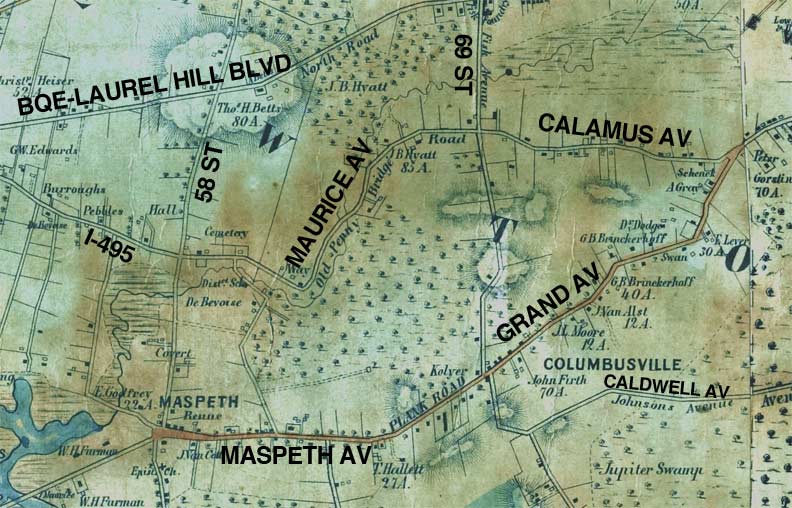Maspeth, in a western corner of Queens east of Greenpoint and Williamsburg, Brooklyn and west of Middle Village, seems stuck between the grit of Brooklyn and the airy, almost suburban feel that its eastern and southern neighbors, Middle Village and Glendale have. Maspeth was first settled by Native Americans for centuries before the middle 1600s and by the Dutch and English after that. It was absorbed by a newer settlement to the east (named, appropriately, Newtown–the present-day Elmhust), became a part of the borough of Queens, and then became a part of New York City in 1898. The name is derived from the Mespatches Indians, who lived there in the precolonial era; some historians say it can be translated to mean “at the bad water place” relating to the many stagnant swamps that existed in the area.
Those swamps are depicted in detail on this Dripps Atlas from 1852, when the area was crisscossed by farm to market roads. As is the norm in Queens, most of the paths of those roads are still in existence today, though they were absorbed by a rough street grid that was imposed beginning in the late 19th Century and more or less completed by World War II.
The main route through Maspeth was the Plank Road, which was bridged across Newtown Creek until the 1870s. It continued east to the heart of Newtown )now Queens Boulevard at Grand Avenue) and is now defined by Maspeth and Grand Avenues. Not yet in existence in 1852 was the western extension of Grand Avenue across the creek into Brooklyn, while the Brooklyn and Newtown Turnpike, now Flushing Avenue, was not yet built; it would meet the Plank Road at the “V” in my MASPETH AV notation.
Much of this map now features cemeteries: New Calvary and Mount Zion, on either side of 58th Street, which was called Betts Avenue for a time because Thomas Betts had large holdings in the area. An unnamed road in the NW corner of the map ran along the south end of both cemeteries; its path is now defined by I-495, the Queens-Midtown Expressway, which becomes the Horace Harding Expressway and then the Long Island Expressway east of Queens Boulevard. The north end of those cemeteries, meanwhile, was defined by Shell Road, so-called because of its paving material. This is now the Brooklyn-Queens Expressway and its service road, Laurel Hill Boulevard.
Columbusville was a small town along Grand Avenue east of 69th Street. A walk through this area will still reveal small, interlocking streets with occasional one-story houses. Much of it succumbed when I-495 went through in the 1950s.
Streets we know today as Grand, Calamus, and Caldwell Avenues today ran uneven, winding courses that still exist. Why build roads this way? Either to avoid hills, which gave the horses trouble, or to get around swampy ground that flooded easily with rains. Such hills have been leveled and the swamps drained, but the twists and turns are still there.
Fisk Avenue (69th Street) along with Betts (58th) was the main north-south route. The Fisk Avenue name is preserved at the #7 train 69th Street station.
The Moore name, seen occasionally on the map, were the Moores that produced Clement Clark, who by most accounts wrote the classic “The Night Before Christmas.” He wound up settling in western Manhattan on an estate called Chelsea. The original Moore homestead, at Broadway and 45th Avenue, survived until the early 20th Century and is now the site of a public park.
A close look at the map reveals a number of rivulets and streams. Some were drained, while some were moved underground into the present sewer system. See FNY correspondent Sergey Kadinsky’s Hidden Waters Blog for some of their stories.
Also: Flushing 1852
Check out the ForgottenBook, take a look at the gift shop, and as always, “comment…as you see fit.”
8/30/17


1 comment
Came home from the hospital to 59-66 61st Street. Out to Queens Village in 1941. My first NYC home in Maspeth.